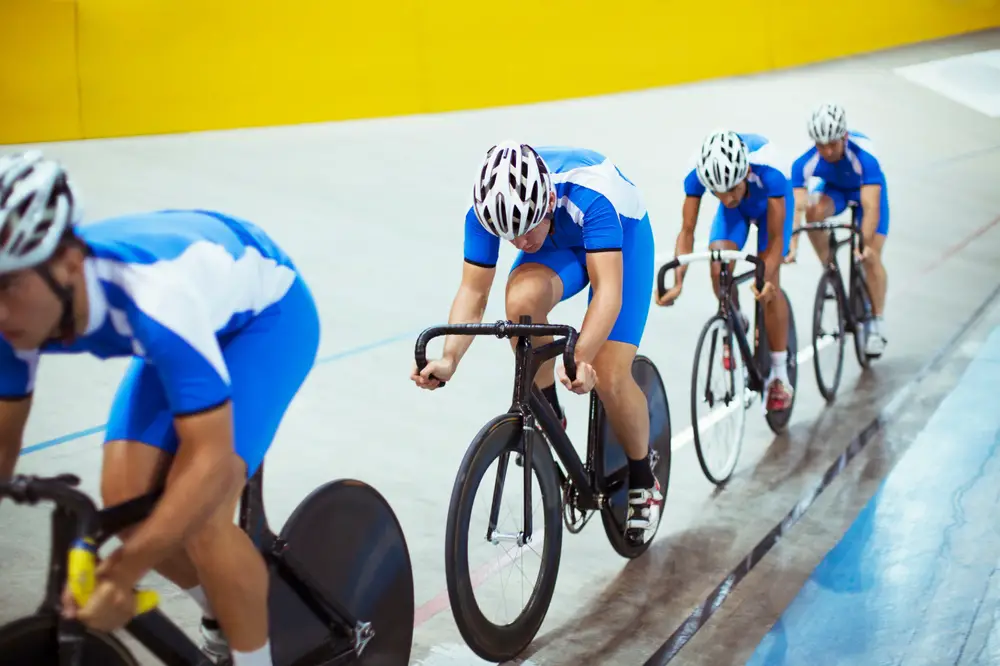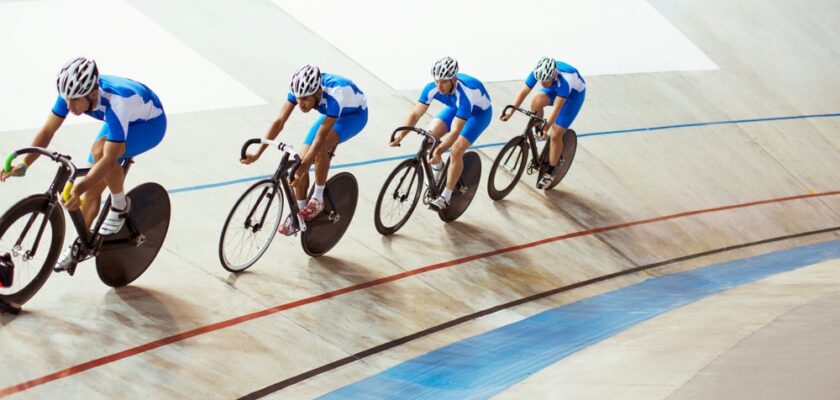O track cycling is a cycling discipline that takes place on velodromes, which are basically oval tracks specially designed for competitions. The sport combines speed, strategy and endurance, requiring cyclists to have many technical skills and a thorough knowledge of its rules.
The rules of track cycling are detailed and specific, ensuring that competitions are fair, safe and exciting for all participants. With this in mind, we’ve prepared a guide to help you understand them.
In this article on the rules of track cycling, we’ll cover the structure and size of the velodrome, the duration of the races, scoring, the number of riders, infractions and penalties, and much more! Understanding these rules is essential for cyclists and fans alike.

Open your Betano account and get up to 1,000 reais in bonuses.
PIX payments, live games and super odds!
Click here to open your account!
Track cycling rules: complete list
- Velodrome;
- Duration;
- Scoring;
- Cyclists;
- Infractions and penalties;
- Equipment;
- Categories.
Track cycling rules: velodrome
A cycling track, also called a velodrome, is an oval structure that can vary in length. However, most modern tracks tend to measure 250 meters in length.
The steepness of the bends is an outstanding feature of track cycling, and can reach 45 degrees, allowing riders to maintain high speeds without skidding. The tracks are made of wood or concrete, leaving the surface smooth and even.
In addition to the main track, the velodrome has other important areas, such as the waiting area and the changeover zone. This is where cyclists wait for their turn to compete or make changes in team events.
The markings made on the track are crucial for competitions, including the finish line, the sprint line (200 meters before the finish) and the blue line. This is because they define the rest area for cyclists outside the competition.
Track cycling rules: duration
The duration of track cycling events can vary according to the type of competition. Some of the most common competitions are:
- Sprint: usually contested over three laps, with the action concentrated in the last 200 meters.
- Keirin: usually consists of six to eight laps, with riders following a bike (derny) for part of the race.
- Points race: this can last from 20 to 50 km, with intermediate sprints every 10 laps.
- Madison: consists of a 50 km relay race for teams of two cyclists, lasting around 45 to 60 minutes.
- Individual and team pursuit: is contested over 4 km for men and 3 km for women, with teams of four cyclists.
Each of these races has its own specific time and distance, but all are precisely timed to ensure equality and compliance with the rules.
Track cycling rules: scoring
Scoring in track cycling depends on the type of race:
- Sprint and Keirin: cyclists are ranked based on their final position at the finish line.
- Points race: points are awarded in the intermediate sprints and at the finish, with additional points for laps won in relation to the main peloton.
- Madison: is similar to the points race, with intermediate sprints and points for laps won.
- Omnium: is a competition made up of several races (scratch, time trial, elimination and points race), where cyclists accumulate points in each race.
The points are counted to determine the winner, making it essential for cyclists to understand how and when to score points to maximize their chances of victory.
Track cycling rules: riders
The number of riders in each race can vary. Here’s how it works!
- Sprint: is contested by between two and four cyclists.
- Keirin: usually has six to eight cyclists.
- Points race and scratch: can have up to 24 cyclists taking part.
- Madison: is usually contested by teams of two cyclists, usually with 18 to 24 cyclists in total.
- Team pursuit: has teams of four cyclists.
The number of riders in each race influences the dynamics and strategy of the competition!
Track cycling rules: infractions and penalties
Infractions in track cycling can result in warnings, disqualifications or time and points penalties. Some of the most common infractions in the sport are:
- Blocking: the action of purposely impeding another cyclist’s progress.
- Leaving the line: happens when a cyclist deviates from the sprint line for no reason.
- Unsportsmanlike conduct: involves actions such as pushing or aggressive conduct, which is extremely forbidden.
- Improper use of the track: when there is improper use of the blue line or the waiting lane.
Race stewards are always on the lookout to ensure compliance with the rules in these cases, and also to apply penalties when necessary, keeping the competition fair and safe for everyone.
Track cycling rules: equipment
Track cyclists use bicycles specially designed for speed and aerodynamics, and they have no brakes and fixed gears. The use of helmets is strictly obligatory, and aerodynamic clothing is common to reduce wind resistance.
Bikes must meet strict specifications in terms of weight, size and components, and are often checked by the stewards before competitions. The use of carbon wheels and other advanced materials is common, providing significant performance advantages.
Track cycling rules: categories
Track cycling competitions are divided into several categories:
- Junior: created for young cyclists, usually under the age of 18.
- Under-23: for cyclists aged between 19 and 22.
- Elite: the main category for adult cyclists.
- Masters: for older cyclists, divided into specific age groups.

Track cycling rules: complete list
- Velodrome;
- Duration;
- Scoring;
- Cyclists;
- Infractions and penalties;
- Equipment;
- Categories.
That’s the list of the main rules of track cycling, which is just one of the cycling disciplines practiced around the world. If you enjoyed learning more about the subject, take the opportunity to check out more articles on this sport and many others! Don’t forget that your comments are very welcome here!



